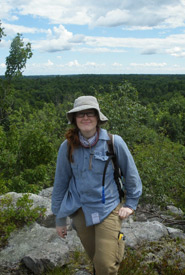Spotting species in Norfolk Forest
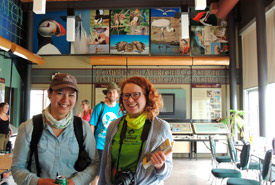
Jenna Siu and Kayla Ellis ready to blitz! (Photo by Amanda Bichel)
It was 11:30 a.m. on an early summer day, and a steady trickle of people were arriving at the Bird Studies Canada (BSC) headquarters in Port Rowan, Ontario. The Norfolk Important Bird and Biodiversity Area BioBlitz was set to start in just a half hour!
There was a giddy air of anticipation as more than 50 natural history experts and volunteers gathered together for the event. Old friends greeted each other, and new acquaintances excitedly talked about what sort of species they would be looking for. Jenna Siu, Kayla Ellis and I represented the Nature Conservancy of Canada (NCC), and we were chiming in with advice on where to search for butterflies, or which trails to take to see a variety of habitats.
Event organizers, Jody Allair and Amanda Bichel from BSC, kicked off the day with some words on the importance of bioblitzes.
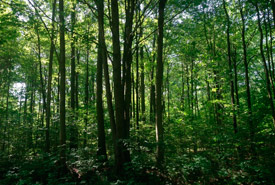
Carolinian forest. (Photo by Jody Allair)
Bioblitzes are intensive, 24-hour surveys of all the living things in an area — essentially, a "biodiversity snapshot." These blitzes can provide useful information to scientists and conservation organizations about a habitat and the species that live there. They’re also a great chance for volunteers to get out and explore the amazing diversity of life in their local natural areas. The Norfolk Forest Important Bird and Biodiversity Area (Norfolk Forest IBA), as the name implies, is a pretty important area for biodiversity.
The Norfolk Forest IBA is one of the best examples of Carolinian forest in Canada. It contains a large number of protected natural areas, including many stewarded by NCC, Long Point Basin Land Trust and Long Point Region Conservation Authority. It’s also home to Turkey Point Provincial Park and St. Williams Conservation Reserve. More than 100 species of breeding birds can be found in the IBA, as well as many rare and at-risk species. It’s a naturalist's paradise!
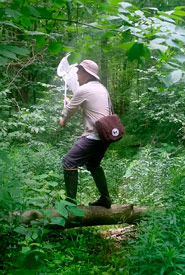
And they're off! Jody Allair ready for bioblitz action! (Photo by Amanda Bichel)
As the clock rolled over to noon, folks took off on the trails and started bioblitzing.
Like many other bioblitzes run by Bioblitz Canada, participants used iNaturalist to collect data. The free smartphone app (Android or iOS) allows for instant sharing of species observations. As the afternoon progressed, more and more species were added to the map. In fewer than four hours, we had crossed the 100 species spotted mark. See all the observations from this bioblitz here.
Meanwhile, back at Bird Studies HQ, dedicated volunteers worked hard entering data, and experts helped identify species. One of my favourite things about bioblitzes is just how much you can learn from the participants. It was amazing to see experts identifying tricky species on the NCC properties where Kayla and I work every day! I brought in samples of a couple of sedges (a type of plant that I have little experience identifying), and in about 10 seconds one of the botanists had identified them and explained some key features to look for.
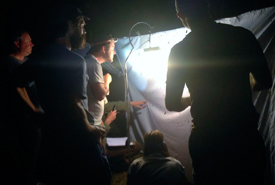
Bioblitz participants stayed up late to survey moths and bats. (Photo by Jody Allair)
Different species are active at different times of day, so bioblitzes last for 24 hours to ensure that nighttime biodiversity is captured too. As the sun set, one group set up a light station to survey moths, and a few of us headed out with special microphones to listen for bat echolocation calls. Whip-poor-wills and frogs started calling too, and soon there was a whole new set of species to add to the list.
By the end of the blitz, there were more than 1,470 species recorded. That's an average of approximately 60 species per hour! As a testament to the Norfolk Forest IBA’s importance to biodiversity, 67 species at risk were recorded. American chestnut, monarch and flowering dogwood were spotted and recorded by many of the groups. The expert birders from BSC added nine species of at-risk birds to the tally as well, including bald eagle, prothonotary warbler and chimney swift. The common spicebush swallowtail butterfly was another star of the day and kept popping up everywhere.
If you get a chance, check out a bioblitz near you! Or just step outside with the iNaturalist app anytime to help contribute to a growing biodiversity database. You might be surprised by how many species you can find!
To see more photos from the Norfolk Forest IBA Bioblitz, check out #NorfolkBioblitz on Twitter and Instagram.

